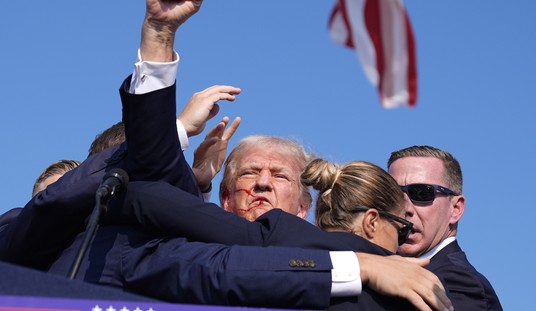
In their latest op-ed, picked up National Review Online, Dick Morris and Eileen McGann conclude “In November 2, when the GOP will win both houses of Congress, the House by a considerable margin. The 2010 landslide will likely set the record for the largest transfer of House seats in an off- year election.” That’s certainly a “pinch me, I’m dreaming” moment for anyone concerned with governmental sanity, and it would a stunning rebuke to the Ruling Class bullying of the last two years. But along the way, Morris and his co-writer drop a serious clanger:
Strangely, the Democrats don’t yet get it. They whistle a happy tune as they march off the cliff. There is no voice of dissent against Obama’s policies, no mumbled animosity, no suppressed discontent. The party is solid as a phalanx behind its leader even as he sends it to political death. It is the Charge of the Light Brigade, and none of them know that “someone has blundered.”
For decades, the liberal alternative glittered attractively on the sidelines. As income inequality increased and Wall Street bonuses excited class animosity, the possibility of an economic-populist response had become more interesting to voters by the time Obama came along. The hyperactive Bush foreign and military policy made the yearning for peace and isolation stronger. And as conservatives increased our national wealth, the glaring omission of the health-care system loomed larger. Finally, when the depression hit, voters called in the liberals from stage left and asked them to take a shot at turning the country around.
And did they ever! They kept their promises and then some. They tripled the deficit and sent the debt soaring. From the moment George Washington took the oath of office until Obama did, America had borrowed $9 trillion. Under Obama, it has borrowed $3.2 trillion more, in less than two years. Our health-care system was deformed, manufacturing was terrified by the prospect of cap-and-tax, GM was absorbed by the government and conquered by the unions, and federalism was buried in an avalanche of subsidies that turned state governments into branch offices of Washington.
Americans have learned their lesson, just as they learned from Hoover the evils of Republican laissez-faire economics. His legacy cast a shadow over politics until Eisenhower vanquished it with his personal popularity in 1952. But it was not until Nixon and Reagan that anti-Hooverism stopped structuring national elections.
In George McGovern, we all saw the incompetence of liberalism, its disorganization, its extremism, and its ultimate impotence. The best testament to his failure as a candidate is his own discovery of the virtues of private-sector capitalism in his old age. This gentleman — who was never anything less than that — clearly paved the way for Ronald Reagan and the conservative ascendancy.
This is likely not the legacy Obama had in mind when, with his massive ego, limited competence, and paltry experience, he took over the White House. Americans, in a fit of national delusion, made what they now realize was one of their biggest mistakes.
Whatever the imagined “evils of Republican laissez-faire economics,” Americans didn’t learn them from Hoover, they learned them from his handling of the Depression was re-imagined and retold to create the legend of FDR’s handling of the Depression, a Sorelian myth if there ever was one. In The Forgotten Man, Amity Shlaes explored just how aggressively Hoover and the GOP attempted to rejigger the economy after the Crash of 1929, often with disastrous results. Or as Ilya Somin wrote at the start of 2009 at the Volokh Conspiracy:
Far from being “unwilling to challenge the pillars of free-market capitalism,” Hoover reacted to the Depression by promoting extensive government intervention. For example, he established the Reconstruction Finance Corporation, a new federal agency that gave massive loans and grants to banks, failing businesses and state and local governments – a policy similar to today’s bailouts. He also supported (albeit reluctantly) the enactment of the Smoot-Hawley tariff, a protectionist measure intended to strengthen American businesses by shielding them from foreign competition. Furthermore, he sponsored a massive increase in federal spending on a variety of relief programs. Similar to today’s Democratic Congress, Hoover sought to stimulate the economy by increasing federal funding for public works through the Emergency Relief and Construction Act.
Speaking before the 1932 Republican Convention, Hoover boasted that he had rejected the “disastrous” option of doing “nothing” and instead had “met the situation with proposals to private business and to Congress of the most gigantic program of economic defense and counterattack ever evolved in the history of the Republic.” In that same 1932 campaign, FDR even denounced Hoover for overspending and promised to enact a balanced budget.
Nor were Hoover’s interventionist policies a sudden change of heart caused by the Great Depression. He had advocated extensive increases in government spending and regulation for years, especially during his time as Secretary of Commerce in the 1920s. Even before the Depression began, the Hoover Administration promoted federal intervention in labor relations and massive farm subsidies.
None of this is news to economic historians. By the 1960s and 70s, research by a variety of scholars had shown that Hoover was anything but a laissez faire advocate. Liberal historian Joan Hoff Wilson’s 1975 book Herbert Hoover: Forgotten Progressive is a good summary of the evidence. It is surprising that an outstanding historian like Brinkley would ignore this body of research.
Brinkley is right, however, to suggest that Hoover’s policies were similar to Bush’s. Like Hoover, the Bush administration responded to an economic crisis with a policy of bailouts. Also like Hoover, Bush sought to push the GOP towards big government policies long before any economic crisis had occurred. Under Bush, the GOP massively increased domestic spending and federal regulation. Bush also, in his own words,“use[d] the mighty muscle of the federal government” to incentivize financial institutions to issue mortgages to borrowers with dubious credit qualifications – an interventionist policy that helped cause the current crisis.
After Hoover left office, New Dealers used the myth of his supposed adherence to laissez-faire as a justification for discrediting free market policies. Today, we are seeing the creation of a similar myth about Bush. The truth, however, is almost the exact opposite of the myth.
The fact that Hoover and Bush pursued interventionist policies doesn’t in and of itself prove that free markets are the way to go. Perhaps Hoover and Bush simply chose the wrong kinds of interventions. Nonetheless, the myth of Hoover as laissez-faire advocate was an important rhetorical prop for supporters of big government policies in the 1930s. Hopefully, it is not too late to forestall the creation of a similar convenient myth about Bush today.
UPDATE: It’s worth noting that FDR strongly denounced Hoover for being overly interventionist during the 1932 campaign. He attacked what he called the GOP’s “reckless and extravagant spending” and warned against Hoover’s tendency to conclude that “we ought to center control of everything in Washington as rapidly as possible.” The later liberal Democratic view of Hoover as a laissez-faire advocate is a post-New Deal invention. When Hoover was actually in office, most Democrats realized that he was an interventionist, and many criticized him for it.
While one can admire National Review for presenting a wide-range of viewpoints on their Website, I’m really surprised that an editor didn’t catch Morris and McGann’s howler and insert a quick red-line, or ask for a rewrite of a sentence that’s pure liberal conventional wisdom.










Join the conversation as a VIP Member